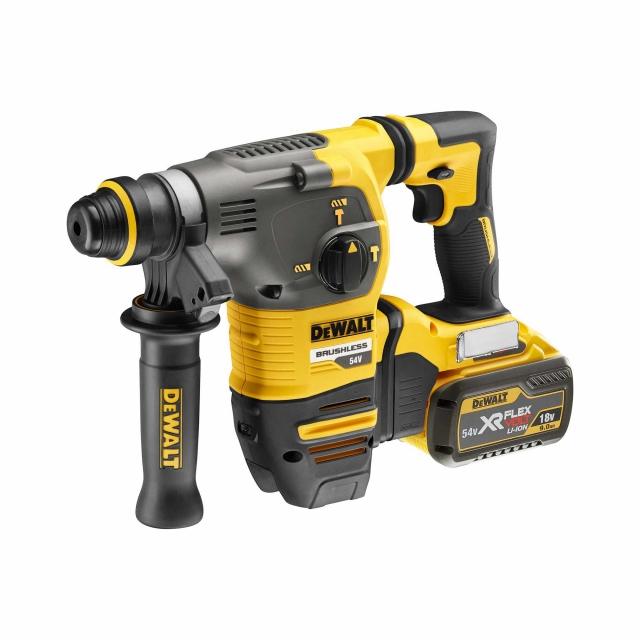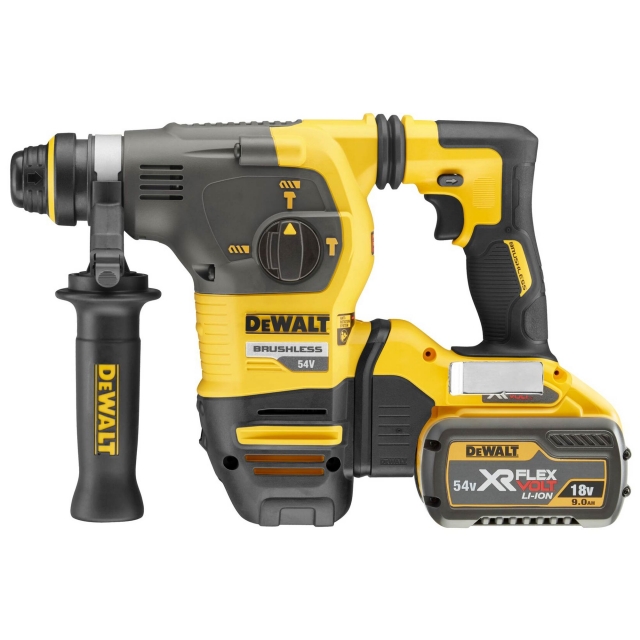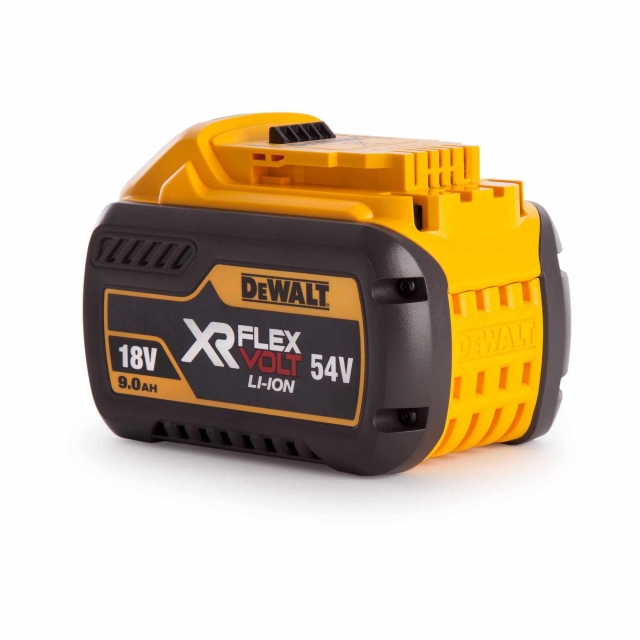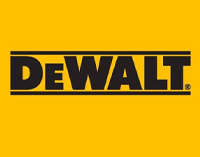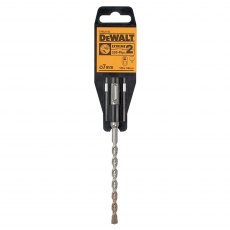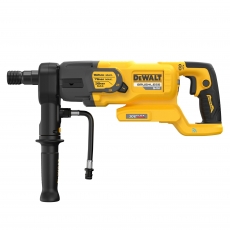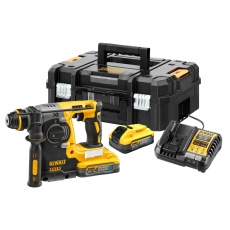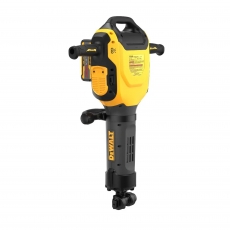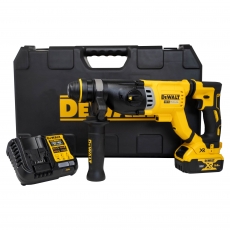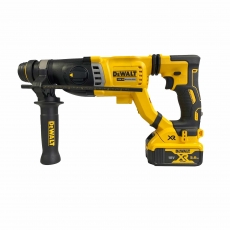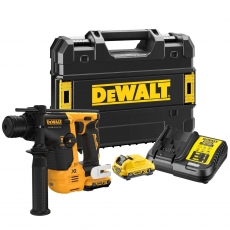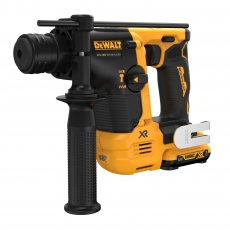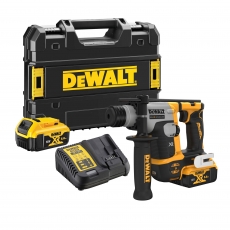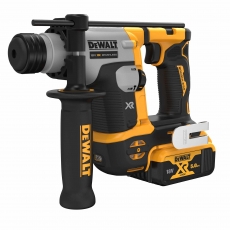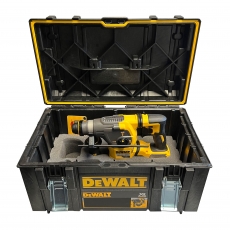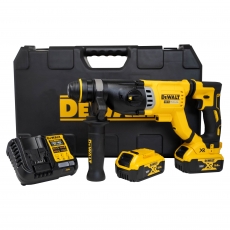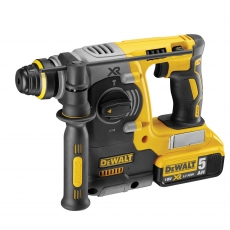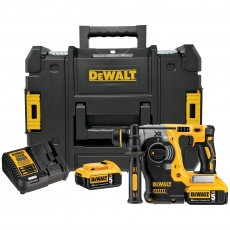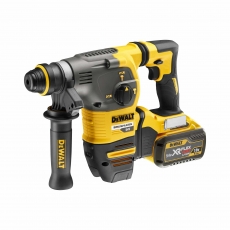DEWALT DCH333X2 54v Flexvolt SDS Plus Hammer Drill with 2x 9ah Batteries
DEWALT DCH333X2 54v Flexvolt SDS Plus Hammer Drill with 2x 9ah Batteries
 Hurry, low stock
Hurry, low stockWhy Not Add
VAT (£2.43 ex VAT)
VAT (£2.64 ex VAT)
VAT (£13.91 ex VAT)
VAT (£38.27 ex VAT)
What’s Included
- 2 x 54v 9Ah Flexvolt Batteries
- Multi Voltage Charger
- Multi Position Side Handle
- Heavy Duty Carrying Case
- Number of Batteries Supplied: 2
- Type: Brushless
- Voltage: 54v
Product Overview
The DeWalt DCH333X2 hammer drill's powerful brushless motor, with high capacity XR Flexvolt 9 ah 18v/54v Lithium-ion battery platform, makes this tool ideal for drilling anchors and fixing 4 mm to 30 mm holes into concrete, brick and masonry.
Part No: DCH333X2-GB(DEWPDCH333X2)
Features & Benefits
- The DeWalt DCH333X2 is a category leader in high speed drilling performance and benefits from rotation stop mode for light chiselling in render, tiles and plaster, and impact stop mode for rotary only drilling into wood and metal.
- The bright, white LED light helps to increase visibility while the Perform and Protect function boasts a best in class vibration at 8.5m/s², reducing user-fatigue.
- Despite its power, the DCH333 boasts a light and compact, ergonomic design for improved support and comfort.
Technical Specification
- Voltage: 18v/54v Flexvolt
- No. of Batteries: 2
- Impact energy: 3.5 Joules
- No-load speed: 0 - 1100/min
- Full load impact rate: 0 - 4300/min
- Drilling capacity: Concrete: 30 mm
- Drilling capacity: Wood: 30 mm
- Drilling capacity: Steel: 13 mm
- Weight: 4.1 kg
The DeWalt DCH333NT 54v FlexVolt SDS hammer drill is an excellent tool for high-speed drilling performance. Renowned for its versatility, this DeWalt drill is perfect for drilling anchors and 4mm to 30mm fixing holes in concrete, brick, and masonry. With its rotation stop mode, it can also be used for light chiselling in render, tiles, and plaster. Additionally, the impact stop mode allows for rotary-only drilling into wood and metal.
The DeWalt DCH333X2 enables heavy-duty construction applications to be completed without the need for mains power. The brushless motors have been designed to run cooler and more efficiently, enabling for more power to be delivered during application, resulting in less wear and increased longevity of the tool. The drill is ideal for drilling anchors and fixing holes into concrete, brick and masonry from 4mm to 30mm. It has 'best in class' vibration of 8.5 m/s² which reduces user fatigue and maximises operating periods.
This tool is supplied with two 9ah 54v batteries, a charger and carry case.
Reviews

FAQs
Cordless SDS Plus Hammers are tools which pack a lot of punch. They’re designed for driving into masonry, which means that they need to rotate as quickly as possible. On top of that, because their primary role is as a hammer drill, the impact rate – measured in either impacts per minute (ipm) or blows per minute (bpm) is definitely an important characteristic to consider. You should also check the maximum drilling capacity, which determines how far the tool will go into the material you’re working with.
The main differences are in the kind of drill bits they use and the amount of power they can bring to a task. Slotted Drive System drills use bits with slots or indentations and a pair of sprung ball bearings at the end of the shaft, which ensure a snug fit into the chuck. The fact that SDS drills usually have faster rotations and provide more blows per minute sets them apart from a ‘traditional’ hammer drill and makes them particularly suitable for tougher drilling tasks, such as driving into concrete.
One significant difference between these kinds of tools is the size of the shank. SDS Plus bits typically have a 10mm shank, while SDS Max is 18mm. This means that an SDS Max tool can use SDS Plus drill bits with an adaptor, but SDS Max bits aren’t ‘backwards’ compatible. The other main difference is that an SDS Max drill has even more power than an SDS Plus tool and is designed for working on tougher jobs than you might use the SDS Plus machine for.
Brushed motors use carbon brushes to transfer power from the fixed part of the motor to the rotor. This creates a reliable and relatively inexpensive motor, but brushed motors do require regular maintenance, in order to either clean the brushes or replace them as they wear out. A brushless motor, by contrast, uses a magnet mounted on the rotor to generate the power and electrical switching to perform the function carried out by the brushes. The additional complexity of the motor’s working means that brushless motors are usually more expensive than brushed.
However, eliminating the brushes also eliminates internal friction and maintenance, meaning that brushless motors offer both increased power and a longer working life. Brushless motors also generate less heat and noise and so, on balance, are considered superior to brushed motors.
That depends entirely on what your SDS Plus Hammer needs to do. One useful rule of thumb is to remember that the higher the voltage of the tool, the more it should be able to do. As an example, a 12v machine will usually have a drilling capacity in concrete of less than 15mm; the new 54v tools from DeWalt can drill to 30mm. We also have 18v, 36v and 40v options, from leading brands including Hikoki and Makita.
Delivery & Returns
Warranty
Related Products
VAT (£629.24 ex VAT)
VAT (£414.00 ex VAT)
VAT (£1,534.39 ex VAT)
VAT (£184.44 ex VAT)
VAT (£135.66 ex VAT)
VAT (£239.97 ex VAT)
VAT (£286.82 ex VAT)
VAT (£269.21 ex VAT)
VAT (£246.95 ex VAT)


